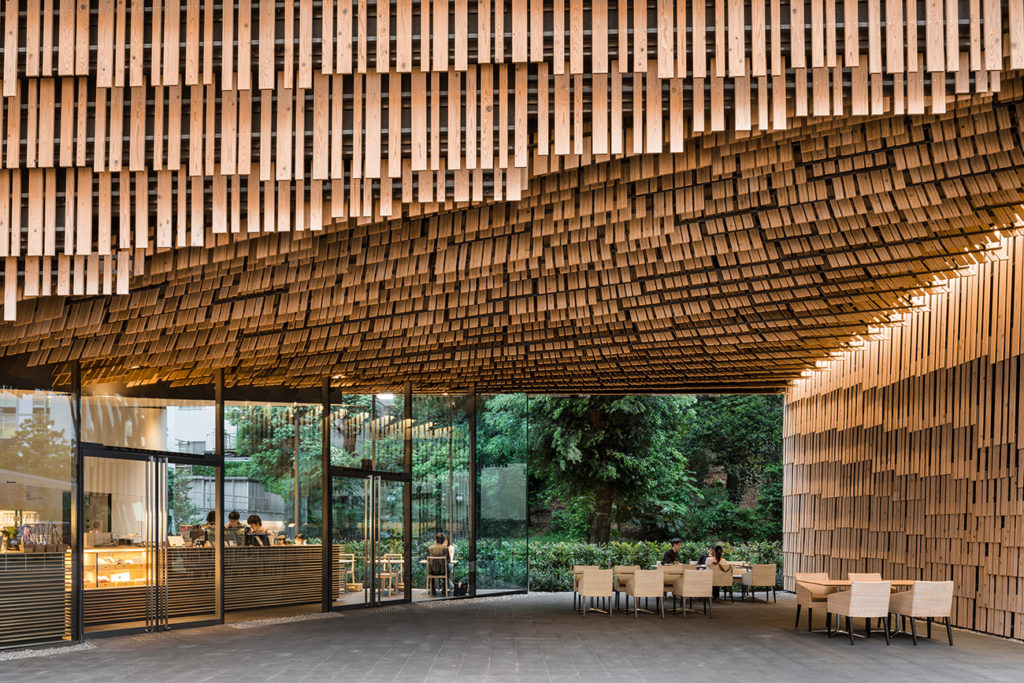
All eyes are on Japan this week as its capital finally hosts the much delayed 2020 Tokyo Olympic Games. But while athletics fans will be tuning in for the sports, architecture fans can feast their eyes on the woven nest-like stadium, designed by Japanese ‘starchitect’ Kengo Kuma,in collaboration with Taisei Corporation and Azusa Sekkei.
Born just outside of Tokyo, Kengo Kuma has used his hometown to test his ideas. Its streetscape reads like a map of his career, starting with the early Great (Bamboo) Wall House and culminating with the US$1.4bn, 68,000-seater Japan National Stadium, which Kuma hopes will be ‘the catalyst that will transform Tokyo back from a concrete city. I want it to set an example that will help alter the direction of Japanese architectural design.’
While the scale and geography of his projects have grown over the years, a red thread connecting the most humble intervention to his grandest is how Kuma’s architecture merges with nature.

Taschen’s upcoming tome, titled ‘Kuma, Complete works 1988 – Today’, offers a richly illustrated overview of Kuma’s oeuvre, delving into his complete archive of built landmarks across the globe in XXL format, via 500 photographs, plans and drawings.

Yusuhara Machino-eki market place in Kochi, Japan
Thatch panels recall agrarian architecture and traditional ‘Chad Do’ rest stops at the Community Market in Yushuhara. Designed for a town of just 3,900 inhabitants, the building functions as a marketplace for locals and a 15 room boutique hotel for travellers passing along the main mountain road, who in historic times stopped at ‘Cho Do’ guest rooms to recuperate and drink tea.
Rugged thatch juxtaposes sleek glass panes used for the building’s lower volume, placing tradition and modernity in dialogue in one architectural gesture. Kuma’s use of the roof thatch panels as a horizontal cladding is innovative. It protects the building from rainfall while also creating a breathable membrane for the building panels pivoting to allow for natural airflow. KKAA’s signature cedar logs are used inside to add texture and regional character to its lofty volumes.
Photography: Takumi Ota
Courtesy of Taschen

Daiwa Ubiquitous Computing Research Building at the University of Tokyo, Japan
For the University of Tokyo’s 2010 computer research building, eschewed hi-tech and concrete campus aesthetics – ditching convention along the way. Hundreds of slender cedar slats cover the facade of the 68,000 sq m partially sunken building, which includes two subterranean levels.
‘Our aim was to break away from conventional image of campuses that consist of hard materials such as concrete, metal or stone, and to instead design a soft building made with wood and earth,’ said KKAA. Instead, ‘scales’ have a fragile, organic and undulating appearance that wraps around the ground level opening, which directs light and wind across the campus.
Photography: Takumi Ota, courtesy Taschen

V&A Dundee in Scotland
The undulating, prow-like form of the V&A Dundee cantilevers over the River Tay like a ship about to launch – paying homage to the Scottish city’s ship-building heritage.
Kuma drew inspiration from the craggy Scottish cliffs when designing the building, which doubles as a concert venue and acts as a ‘living room’ for the city and is its landmark cultural venue conceived for its tenure as City of Culture in 2019.
In contrast to the building’s stark and imposing industrial exterior, its interior spaces are bright, light and wrapped in native timbers – a Scottish take on his typical Japanese-style cedar interiors.
Photography: Hufton + Crow
Courtesy of Taschen

Shipyard 1862 in Shanghai, China
In 2018, KKAA completed the revival of a disused shipyard, masterminding its adaptive reuse as a theatre and retail destination and wrapping it in a new brick facade to boot. The shed dates from the 1970s and was the last built along this stretch of the Huangpu River, during Shanghai’s shipbuilding heyday.
Kuma used the structure’s location to curate views across the site. The theatre is situated in the east end of the building, with views of the riverbank dramatically revealed by a heavy curtain, while Kuma’s perforated brick facade creates delicate shadow-play.
‘We have designed the main façade (west side) as a brickwork gradation changing its density and permeability from the opacity of the north side into the complete transparency of the south side,’ explains KKAA.

Folk Art Museum China Academy of Art in Hangzhou, China
Taking 6 years to complete, Kuma’s Folk Art Museum opened to rapturous praise in 2015 for its site-specific design, which riffs on the rural vernacular of Hangzhou.
The museum occupies a sloping hillside with its angled volumes spilling gently down the hillside, their pitched roofs mimicking tightly-packed village houses when viewed from afar.
Photography courtesy of Taschen

The Exchange Sydney, in New South Wales, Australia
Opened in early 2020, Sydney’s Exchange building is Kuma’s first in Australia and houses the city’s civic services and offices for Darling Harbour.
Its off-kilter ‘rings’ are reminiscent of a bamboo basket or beehive with levels staggered to reveal glimpses of activity inside the building.
The structure itself is wrapped in 20,000 metres of light-coloured timber. The lattice-work enlivens the streets around the building with intricate shadow-play.
Photography: © Martin Mischkulnig

‘Kuma, Complete works 1988 – Today’ is published via Taschen priced at £150
Whereas many architects have experimented with high-futurist forms and dominating the landscape, Kuma’s buildings tread lightly on the environment, constructed largely with natural, sustainable materials. They have a ‘Kuma style’ that’s specific to their location from the silvery hues of V&A Dundee’s riverbank museum to the cedar shingles of his University of Tokyo addition.
As we approach the Olympics opening ceremony, we delve into a handful of our favourite Kengo Kuma-designed buildings in Japan and beyond.
‘Kuma, Complete works 1988 – Today’ is published in September 2021 via Taschen, priced at $200























